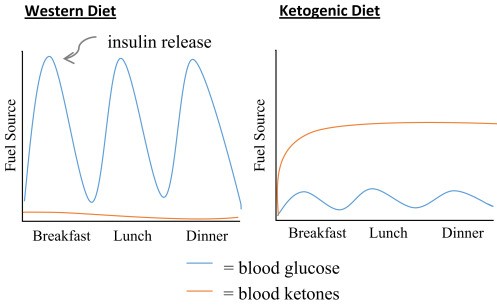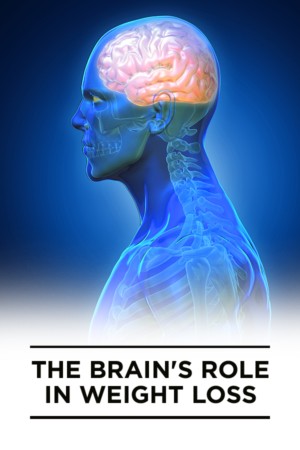We’ve all been there: the dreaded mid-afternoon energy crash where you’re ready just to call work quits and head back to the bed for some quality time with your pillow. This is largely an indication of the effects that a typical Western diet has on your body, a diet which is, of course, dominated by carbohydrates.
Where the energy comes from
Carbs provide rapid boosts of energy, but they deplete quickly as well. Fat doesn’t offer quite the energy spike that carbs do, but it’s more consistent throughout the day. This difference is one of the reasons why the ketogenic diet is very popular with endurance athletes, but participants in sports that require quick bursts of energy tend to carb load. What’s best for you? Well, let’s explore how this works.
Check out this chart1 that shows energy throughout the day for a person utilizing glycolysis (i.e., carbs as energy) versus ketosis (i.e., fat for energy). What you find is that carbs provide energy spikes when you eat a meal loaded with them, while ketosis is even-keeled throughout the day.

Very few of us have jobs that require intense, quick bursts of energy. When we eat a carb-laden diet, the body converts the carbs into glucose (for immediate use), and anything that’s left over is converted into glycogen. The body can only store so much glycogen in the muscles and liver, so after this step is full, everything that remains converts into fat. The primary cause of excess fat in Western diets is excess carbohydrates.
What kind of energy you need
Let’s talk about the other 99 percent of us: our occupations range from sedentary desk jobs to very active construction work, and everything in-between. What all of these have in common, however, is the need for sustained, consistent energy levels. Even the most active manual labor is done consistently over 8-12 hours, not ten minutes of intense exertion every four hours with 3 hours and 50 minutes of rest in between. The overall amount of energy required varies widely, but the pattern of energy remains the same.
Ketosis is incredible for this because it conditions the body to use fat as fuel. Once you’re fat adapted and the body becomes efficient at ketosis, it easily transitions from consumed fat (e.g., the cheese you ate at breakfast this morning) to stored fat (i.e., the stuff you want to get rid of anyway). This is why you can have such a steady energy state throughout the day: ketones are continually being replenished at a consistent rate.
What life looks like on keto
I used to require a mandatory cup of coffee or a Monster every afternoon around 2 pm. I’d find myself nodding off at my desk, trying to stay attentive. I used a standing desk, I took a walk—even brief bursts of physical activity weren’t enough to snap me out of the funk. Eventually, even the coffee and energy wasn’t enough, so I had to snack. Because I wasn’t on ketosis, I needed a quick injection of carbs. As you can imagine, that led to increased weight gain.
Since I’ve been on keto, my energy levels exactly resemble what you see on the chart. It’s steady throughout the day, and even when I’m hungry, I’m never hangry. When you’re hangry, the need to feed begins to take on an emotional side: we’re upset more easily, we tend to snap at small things more readily, and overall we’re just more unstable. This is such a well-known and widely-accepted phenomenon that it’s become the foundation of entire ad campaigns, such as Snickers “You’re Not You When You’re Hungry” series.
What does Snickers do? It provides a quick hit of carb-laden energy, bringing you back to normal. Unfortunately, that hit will cost you 215 calories, which would take about an hour to walk off. We do the same with coffee when we load it with sweetener or go after an energy drink that’s packed with sugar. Some people even go so far as to take energy supplements in pill form, normalizing their habit of needing energy that they’re not getting from their diet.
If you’re on keto, however, you don’t need to do anything other than stick to your macros. In fact, one of the common practices of “keto-ers” is intermittent fasting, where we intentionally restrict our eating times to a 4-, 6-, or 8-hour window during the day… and we’re able to maintain a steady energy state throughout.
If you’re not on a low-carb diet, you’re going to be constantly chasing energy shortcuts. Give that hangry state of mind up and go keto!
NUTRITIONAL DISCLAIMER
The content on this website should not be taken as medical advice and you should ALWAYS consult with your doctor before starting any diet or exercise program. We provide nutritional data for our recipes as a courtesy to our readers. We use Total Keto Diet app software to calculate the nutrition and we remove fiber and sugar alcohols, like erythritol, from the total carbohydrate count to get to the net carb count, as they do not affect your blood glucose levels. You should independently calculate nutritional information on your own and not rely on our data. The website or content herein is not intended to cure, prevent, diagnose or treat any disease. This website shall not be liable for adverse reactions or any other outcome resulting from the use of recipes or recommendations on the Website or actions you take as a result. Any action you take is strictly at your own risk.
- The Brain’s Role in Weight Loss - March 11, 2019
- Making Fat Loss EPOC - March 8, 2019
- Overcoming Plateaus - March 6, 2019




